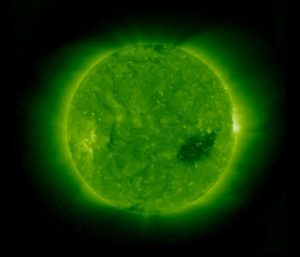Can the Sun Cool the Earth?
Genesis 8:22
“While the earth remaineth, seedtime and harvest, and cold and heat, and summer and winter, and day and night shall not cease.”
 Our sun, though remarkably stable as stars go, follows an eleven‑year cycle of activity. Every eleven years the sun’s surface is torn by solar storms. These storms can send a hot blast of particles at the earth at a million miles per hour. When they hit the Earth, these particles can disrupt radio communications and electrical systems. During this peak, the sun’s magnetic field is at its strongest.
Our sun, though remarkably stable as stars go, follows an eleven‑year cycle of activity. Every eleven years the sun’s surface is torn by solar storms. These storms can send a hot blast of particles at the earth at a million miles per hour. When they hit the Earth, these particles can disrupt radio communications and electrical systems. During this peak, the sun’s magnetic field is at its strongest.
Five and one-half years later, the sun is relatively quiet. During this quiet period, the sun’s magnetic field is at its weakest. As a result, the sun’s atmosphere develops leaky holes. These openings, called coronal holes, eject protons and electrons into space at two million miles per hour. Now two climatologists have collected data that indicate that during this quiet period, the sun may actively cool the Earth. They studied 20 years of temperature data from weather satellites and found that the Earth’s temperature average was lowest when the sun had the most and largest coronal holes. In 1995, the sun’s surface was covered with coronal holes and the Earth’s lower atmosphere averaged two degrees cooler than when the sun was most active. They theorized that some of the particles ejected from the sun enter the atmosphere and serve as nuclei for water droplets, increasing cloud formation and cooling the lower atmosphere.
While we have much to learn about the sun, we can thank a loving Creator for giving us a uniquely stable sun that supports life. Author: Paul A. Bartz
Prayer: Dear Father, I thank You for Your promise of stable seasons. Amen.
Ref: Discover, 7/00, “Hot Blast of Cold Weather.” Photo: The solar disk with a coronal hole. Courtesy of NASA. (PD)